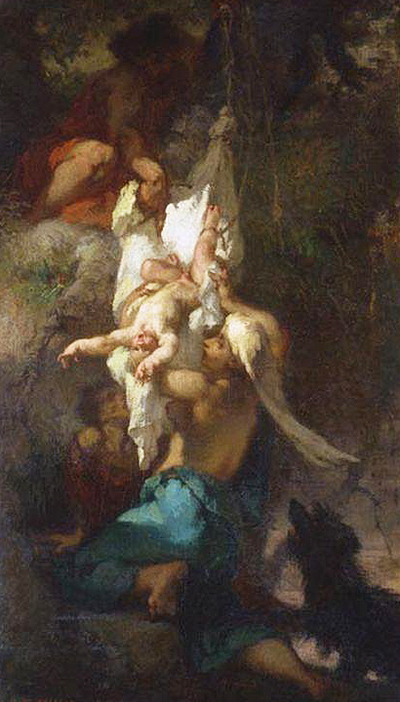Painted by Jean-François Millet in 1847, Oedipus Taken Down from the Tree is based on a Greek myth. Oedipus is being taken down from a tree, by shepherds, after he was strung up there by his father, Laius, because he believed that his son would kill him. The oil painting can now be seen at the National Gallery of Canada. Paintings associated with Greek mythology were rare for Millet, as he is better known for producing paintings of peasant farmers, due to being born into a farming community in 1814. As he grew older, he was needed to assist his father with farm work, and this became the main focus of his art.
His career as an artist began in 1833, when he was sent to Cherbourg, by his father, to study under the portrait painter Bon Du Mouchel. He also studied with Théophile Langlois de Chèvreville, who in turn was taught by Baron Gros. In 1837, Millet moved to Paris to study at the École des Beaux-Arts, under Paul Delaroche. However, he lost his scholarship a couple of years later, and his first submission to the Salon (the exhibition at École des Beaux-Arts) was rejected. A year later, a portrait was accepted into the Salon, but Oedipus Taken down from the Tree was considered to be his first real success at the Salon.
Millet inspired some famous artists with his work. Vincent van Gogh wrote about Millet to his brother Theo during the early part of his career. Claude Monet also found Millet's later landscape paintings to be inspirational, and Georges Seurat followed his work too. He didn't just influence fellow artists either. Edwin Markham wrote his poem The Man With the Hoe based on Millet's painting L'homme à la Houe. Millet is also the protagonist in Mark Twain's play Is He Dead?, which tells the story of a poor artist that faked his own death.
His painting The Angelus was reproduced many times during the 19th and 20th centuries, and was of particular fascination to Salvador Dalí. Dalí insisted that the figures in The Angelus were praying over the grave of their dead child. To prove this, an X-ray was taken of the canvas, and the imprint of a coffin-like shape can be seen at the bottom of the painting. It is not known if this was intended, or if Millet just changed his mind and painted over it.




